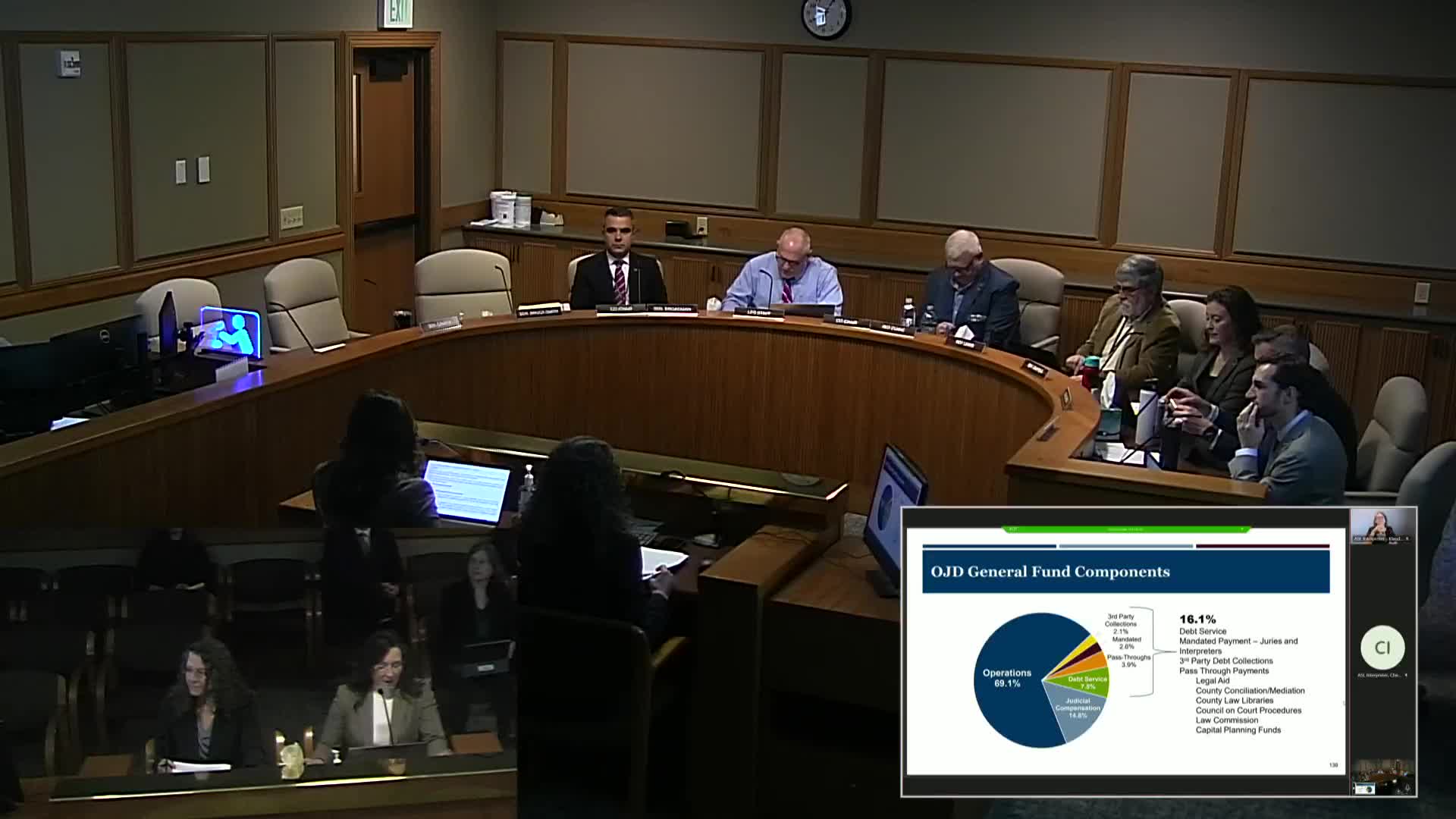Oregon courts face severe budget cuts threatening access to justice and timely case processing
February 26, 2025 | Public Safety, Ways and Means, Joint, Committees, Legislative, Oregon
This article was created by AI summarizing key points discussed. AI makes mistakes, so for full details and context, please refer to the video of the full meeting. Please report any errors so we can fix them. Report an error »

In a pivotal meeting of the Oregon State Legislature's Joint Committee on Ways and Means Subcommittee on Public Safety, officials laid bare the stark realities facing the state's judicial system. As discussions unfolded, the emphasis was clear: the budget constraints are not just numbers on a page; they represent the very fabric of justice in Oregon.
Under the soft glow of fluorescent lights, the committee members listened intently as budgetary challenges were outlined. A pie chart illustrated a troubling truth: nearly 84% of the judicial budget is consumed by personnel costs, including judges and staff. This heavy reliance on human resources makes it nearly impossible to absorb any cuts without dire consequences. The total legislatively approved budget for the 2023-2025 biennium stands at approximately $1.2 billion, with the General Fund contributing $735.5 million. However, the current service level budget of $893.9 million is already falling short of what is necessary to maintain essential services.
The meeting highlighted several pressing issues driving costs higher. An increase in unrepresented defendants is causing significant delays in the legal process, leaving many in a state of legal limbo. Additionally, the rising number of evictions has created an urgent need for legal assistance, while a shortage of interpreters and mediators further complicates access to justice. The aging infrastructure of courthouses adds another layer of urgency, as many facilities are deemed unsafe or inadequate for modern operations.
As the discussion progressed, the potential impact of budget cuts became increasingly alarming. Without the additional funding requested, the judicial system could face a 2% cut to operations, which translates to the loss of over 42 staff positions or the equivalent of 14 court closure days statewide. Such reductions would not only slow down case processing but also limit access to justice for Oregonians, exacerbating an already overburdened system.
The Chief Justice's recommended budget for the 2025-2027 biennium seeks to address these challenges with a proposed $1.23 billion allocation. This budget aims to prioritize investments in safe courthouses, adequate judicial compensation, and timely case processing. However, the stark reality remains: without sufficient funding, the courts may struggle to serve their communities effectively.
As the meeting drew to a close, the message was clear: the stakes are high. Cuts to the judicial budget would not only hinder the courts' ability to function but could also lead to a significant backlog of cases, potentially doubling the current number of pending cases by 2026. The committee's deliberations underscored the urgent need for a sustainable solution to ensure that justice remains accessible and efficient for all Oregonians.
Under the soft glow of fluorescent lights, the committee members listened intently as budgetary challenges were outlined. A pie chart illustrated a troubling truth: nearly 84% of the judicial budget is consumed by personnel costs, including judges and staff. This heavy reliance on human resources makes it nearly impossible to absorb any cuts without dire consequences. The total legislatively approved budget for the 2023-2025 biennium stands at approximately $1.2 billion, with the General Fund contributing $735.5 million. However, the current service level budget of $893.9 million is already falling short of what is necessary to maintain essential services.
The meeting highlighted several pressing issues driving costs higher. An increase in unrepresented defendants is causing significant delays in the legal process, leaving many in a state of legal limbo. Additionally, the rising number of evictions has created an urgent need for legal assistance, while a shortage of interpreters and mediators further complicates access to justice. The aging infrastructure of courthouses adds another layer of urgency, as many facilities are deemed unsafe or inadequate for modern operations.
As the discussion progressed, the potential impact of budget cuts became increasingly alarming. Without the additional funding requested, the judicial system could face a 2% cut to operations, which translates to the loss of over 42 staff positions or the equivalent of 14 court closure days statewide. Such reductions would not only slow down case processing but also limit access to justice for Oregonians, exacerbating an already overburdened system.
The Chief Justice's recommended budget for the 2025-2027 biennium seeks to address these challenges with a proposed $1.23 billion allocation. This budget aims to prioritize investments in safe courthouses, adequate judicial compensation, and timely case processing. However, the stark reality remains: without sufficient funding, the courts may struggle to serve their communities effectively.
As the meeting drew to a close, the message was clear: the stakes are high. Cuts to the judicial budget would not only hinder the courts' ability to function but could also lead to a significant backlog of cases, potentially doubling the current number of pending cases by 2026. The committee's deliberations underscored the urgent need for a sustainable solution to ensure that justice remains accessible and efficient for all Oregonians.
View full meeting
This article is based on a recent meeting—watch the full video and explore the complete transcript for deeper insights into the discussion.
View full meeting
